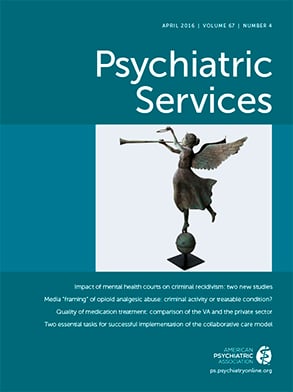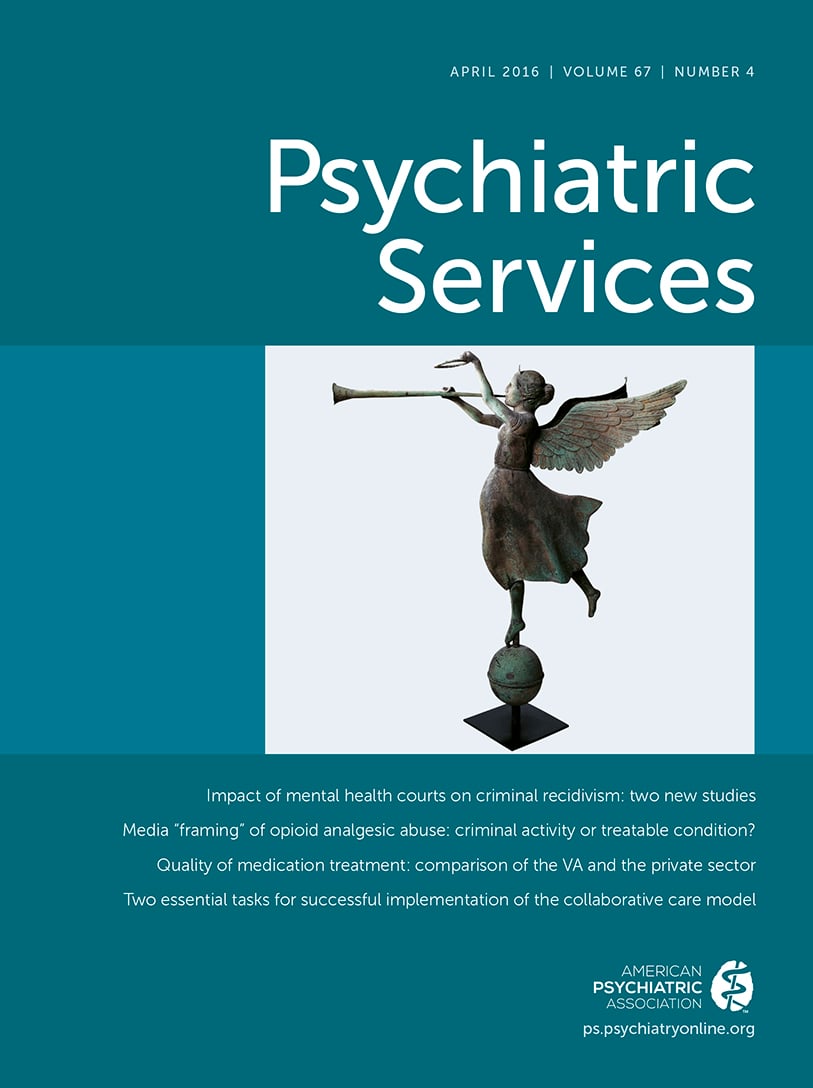A considerable body of literature describes in detail the health problems experienced by homeless populations as a result of exposure to environmental toxins and communicable diseases, chronic stress, and barriers to access to health care. Examples of chronic stressors include low socioeconomic status, malnutrition, and psychiatric and substance use disorders. Exposure to such stressors is associated with chronic disorders, such as hepatitis and cardiovascular disease, and, as a result, substantial risk of early death (
1–
4). In the United States, veterans represent a significant minority of the homeless population. Efforts to reduce homelessness among veterans have had success, but veterans continued to comprise 11% of homeless adults in the United States in 2014 (
5). To date, however, few studies have explored early mortality among veterans who are homeless.
Retrospective studies of veterans with a mental illness who are homeless have shown that mortality rates for this population are higher compared with the general population and with veterans with a mental illness who are not homeless (
6) and that homelessness has an effect on years of life lost above and beyond the contribution of serious mental illness (
7). Analyses of age of death among veterans who died from suicide have shown that veterans who were homeless were significantly younger when they died compared with veterans without a history of homelessness (
8). In a one-year follow-up of veterans receiving care from a regional U.S. Department of Veterans Affairs (VA) health care system in 2010, veterans who were homeless were found to have a 32.3% increase in all-cause mortality compared with veterans who were not homeless (
9). Higher all-cause mortality was found even after the analyses controlled for age, race, gender, serious mental illness, substance use disorders, and comorbidity of general medical diseases.
In summary, the few studies of veterans who were homeless are consistent in suggesting that homelessness is associated with early mortality, even after adjustments were made for the presence of other variables known to contribute to early death. These estimates may be biased, however, given that the study samples consisted of veterans who either were identified in records of medical care or were enrolled in general medical or psychiatric treatment programs.
This study aimed to describe mortality patterns in a large sample of older veterans identified solely by their entry into national VA homelessness programs. Specifically, the analyses examined differences in all-cause mortality, all-cause mortality by age, specific-cause mortality, and death by suicide among veterans who were or were not homeless.
Methods
Data for this study, which was approved by an institutional review board, were provided by the VA Northeast Program Evaluation Center (NEPEC), the Epidemiology Program of the VA Office of Public Health, and the VA Corporate Data Warehouse (CDW). NEPEC provided administrative data for all veterans ages 55 and older who were admitted into VA homelessness programs in 2000–2003. Veterans in these programs qualify for VA health care, and an undetermined number receive such services, but many use community resources for some or all of their health care. This sample included 4,475 veterans.
A control group was created by using administrative records from the CDW containing age, date of birth, and sex for veterans age 55 and older who received medical care from the VA in 2000–2003. The control group’s records were culled to select the veterans’ earliest record of contact after the age of 55. Veterans in the control group with a subsequent history of intervention in VA homeless programs as indicated in NEPEC data for 2000–2011 were dropped from the analyses. The final control sample consisted of 20,071 veterans.
In order to match the age distribution of the homeless and control samples on a group basis, three-year age ranges (55–57, 58–60, and 61–63) were created. The percentage of veterans in the homeless sample for each of these age ranges was determined, and an equivalent percentage of veterans for each age range in the control sample was randomly selected. Because of limited data on the use of VA health care services by the homeless sample, no other variables were used in matching the groups.
The Epidemiology Program provided mortality data from the National Death Index maintained by the Centers for Disease Control and Prevention for 2000–2011. Homeless and control sample records were matched against the National Death Index file to determine survival status, date of death, and cause of death. For mortality analyses, time to death was calculated as the date of death minus the date of entry into the VA homelessness program for the homeless sample and date of first medical care service for the control sample.
ICD-10 codes provided in the National Death Index file were used to determine specific causes of death. Death by suicide was captured by examining the following
ICD-10 codes: intentional self-harm, X60–X84; late effects of intentional self-harm, Y87.0; poisoning of undetermined intent, Y10–Y19; and other events of undetermined intent, Y20–Y34. Descriptive statistics, univariate statistics, and a Kaplan-Meier survival analysis were calculated with SPSS, version 22 (
12). Limited data for the homeless sample precluded adjustment of analyses for covariates.
Results
There was a small but significant difference in mean±SD age between the control (59.4±4.6) and homeless (59.2±4.4) samples (t=2.96, df=24,544, p<.01); however, the effect size (d=.05) indicated that the difference was not meaningful. There was also a small, significant difference in the percentage of females in the control (N=604, 3.0%) and homeless (N=49, 1.1%) samples (χ2=51.784, df=1, p<.001); the effect size (ϕ=.05) showed that this difference was not meaningful. During the follow-up period, 1,560 (35%) veterans in the homeless sample died from all causes, compared with a significantly smaller proportion (N=3,649, 18%) of the control sample (χ2=608.96, df=1, p<.001). Veterans in the homeless sample were younger at time of death (65.0±5.6) compared with the control sample (66.9±5.9; t=10.52, df=1 and 5,707, p<.001). This result produced a small, but meaningful, effect size (d=.32).
To examine the impact of age on survival more specifically, we examined all-cause mortality in old (ages 55–59) and older (ages ≥60) groups. Mean survival times were longest for old veterans in the control sample (132.0±.2 months), followed by older veterans in the control sample (126.6±.4 months) and both homeless groups (116.2±.8 months for old veterans and 106.1±1.2 months for older veterans). Survival rates were highest among old veterans in the control sample (11,128 of 13,139, 85%), followed by older veterans in the control sample (5,294 of 6,932, 76%), old veterans in the homeless sample (2,031 of 2,938, 69%) and older veterans in the homeless sample (884 of 1,537, 58%).
Figure 1 presents the group survival functions, demonstrating substantive decline in survival on the basis of both age and homelessness. Log-rank tests revealed that the overall comparison of differences in survival among the four groups (χ
2=1,140.01, df=3, p<.001) and all pairwise comparisons of the group survival distributions (p<.001) were significant. As
Figure 1 indicates, the largest pairwise difference was between the distributions of older veterans in the homeless sample and old veterans in the control sample (χ
2=940.16, df=1, p<.001). With old veterans in the control sample as the reference group, risk ratios (RRs) for all-cause mortality were increasingly positive for older veterans in the control sample (RR=1.58, 95% confidence interval [CI]=1.44–1.68), old veterans in the homeless sample (RR=2.46, CI=2.23–2.66), and older veterans in the homeless sample (RR=3.64, CI=3.33–3.98).
Eleven ICD-10 categories comprised the specific causes of death for 95% (N=1,489 of 1,560) of the homeless sample and 94% (N=3,424 of 3,649) of the control sample who did not survive through the follow-up period. For both samples, the most frequent categories were cardiovascular diseases (homeless, N=522, 33%; control, N=1,138, 31%), neoplasms (homeless, N=364, 23%; control, N=1,097, 30%), and respiratory diseases (homeless, N=159, 10%; control, N=409, 11%). Compared with the control sample, the homeless sample had higher proportions of deaths due to digestive diseases (N=108, 7%, versus N=193, 5%, χ2=5.39, df=1, p=.02), mental or behavioral disorders (N=71, 5%, versus N=65, 2%, χ2=32.96, df=1, p<.001), infectious or parasitic diseases (N=70, 4%, versus N=61, 2%, χ2=35.31, df=1, p<.001), and accidents or self-harm (N=53, 3%, versus N=69, 2%, χ2=10.83, df=1, p<.001). Deaths due to neoplasms and to endocrine, nutritional, or metabolic diseases were more common in the control sample versus the homeless sample (N=1,097, 30%, versus N=364, 23%, χ2=24.58, df=1, p<.001, and N=233, 6%, versus N=62, 4%, χ2=11.90, df=1, p<.001, respectively). The odds of dying by suicide were significantly higher among veterans in the homeless (N=18, .4%) versus the control (N= 41, .2%) samples (odds ratio=1.93, CI=1.13–3.48; χ2=5.98, df=1, p<.001).
Discussion and Conclusions
We conducted unadjusted analyses of mortality among older veterans identified exclusively by housing status and age. The frequency of all-cause deaths in the 11-year follow-up period was approximately twice as high for the homeless sample (35%) compared with the control sample (18%). Notably, the cumulative survival rate for older (≥60) veterans in the homeless sample was 58%. The RRs for all-cause mortality among homeless veterans were comparable to those previously reported for a sample of veterans who were homeless
6,
9). These results lend further support to the hypothesis of excess mortality among veterans who are homeless and provide estimates of mortality risk for older veterans who are homeless.
Several disease or disorder categories were associated with small and questionably meaningful proportional increases in deaths among veterans in the homeless sample; no single category appeared to be critical in reducing survival time. These results echo those previously reported (
9) and point to a need for more detailed exploration of how environmental stressors might influence mortality among persons who are homeless, especially by examining the concept of accelerated aging. Recent research (
13) on schizophrenia has highlighted the possibility that accelerated aging reflects a broad range of potential risk factors.
Death by suicide was rare; however, suicide was twice as common among the veterans in the homeless sample compared with the control sample, a finding consistent with the relatively high frequency of reported suicidal behaviors among older veterans who are homeless (
10). This result refines earlier findings that veterans who are homeless die by suicide at a younger age than veterans who are not homeless (
8) by showing that suicide is still a potent cause of death among older veterans who are homeless.
Strengths of our study were that homeless veterans were not selected from samples of veterans with psychiatric disorders or substance use disorders. Given that 35% of veterans who are homeless do not have psychiatric or substance use disorders, our study was the first to examine mortality in a sample that was more likely to reflect the actual composition of veterans in the homeless population. An additional strength was that analyses of the control group excluded veterans who received homeless intervention services in the follow-up period.
The major limitation of our study was incomplete data for the homeless sample. Thus we could not provide a detailed description of sample characteristics or conduct analyses that could be adjusted for general medical and psychiatric comorbidities, substance abuse, use of VA and community-based health care services, and other factors. Although a previous study found a substantial increase in all-cause mortality among veterans who were homeless, even after the analyses controlled for the factors mentioned above, similar adjustments will be necessary to obtain more accurate estimates of mortality among older veterans who are homeless (
9). Future studies would be most valuable if they employed longitudinal approaches to explore risk factors for homelessness among veterans and the impact of long-term housing interventions and health care access on longevity among veterans who are homeless. In the interim, however, there appear to be sufficient data to support consideration of focused treatment tracks for older veterans who are homeless within the framework of homelessness intervention programs. This approach might be particularly valuable in Homeless Patient Aligned Care Teams, a nationwide VA program to provide outpatient care services to veterans who are experiencing homelessness.


